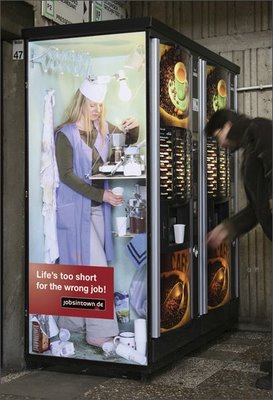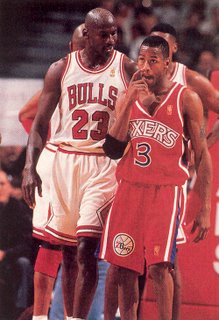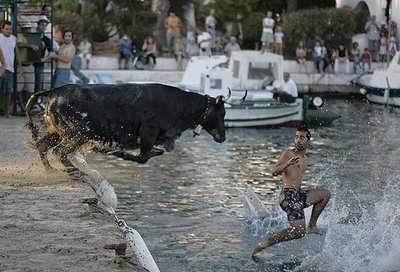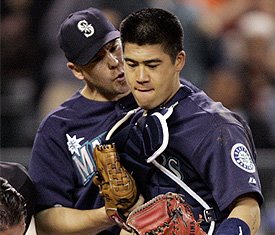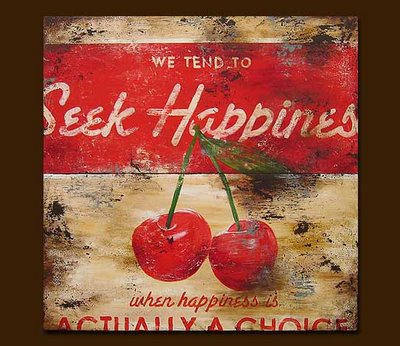Wednesday, May 31, 2006
Drug Pushers
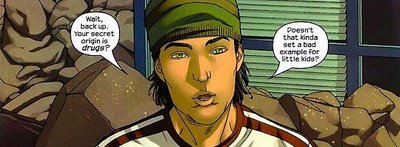
Herewith is an article entitled, No Free Lunch,written by a Capizeno which was distributed during the graduation ceremonies of the College of Medicine, University of the Philippines, Diliman, Quezon City, May 19, 2006. It's a good piece of work reflecting some insights on the high cost of medicines in Philippines...
---------------------------------------------------------------------------------
No Free Lunch
By Raoul A. Bermejo III, M.D.
Email comments to
I am writing this because I am bothered by the fact that our class graduation party was largely paid by a drug company. I heard they had foot the bill of P150,000 pesos for dinner.
Let us be honest and clear about it. It was a party. It was not a scientific meeting.. It was not a course of continuing medical education. People went there to eat, drink and be merry.
I am bothered that our class allowed it. It is patently a marketing scheme from the drug company and our class fell for it. Many feel that they are above the issue thinking they can personally resist being swayed by all these marketing schemes. I think it is quite naïve. Let us not be in denial. Drug companies utilize these schemes because they work. Clear evidence has shown that physicians’ behavior in prescribing medication is affected by these enticing efforts of drug companies.
Where is the marketing money of drug companies coming from? Let us also reflect on this question. Do you really think it is really out of their goodness in their heart? Or their fondness of physicians? Marketing costs are really passed on to the consumers; they are passed on to our patients. Costs from maintaining an army of cute and dapper medical representatives, and costs of cups of coffee, rounds of golf, lunches, tours and various freebies that physicians accept, these contribute to the high prices of medications in the country. While we enjoy freebies; let us reflect on the fact that they come from the pockets of our patients, many of them are poor and could hardly afford the complete course of medications we prescribe.
Drug prices in the country are as much as it is in Western Europe, the U.S. and Canada. Our country, having no real drug industry of its own, it is one of the favorite playgrounds of three big pharmaceutical firms. They are now challenging even the band-aid effort of our government to make essential drugs accessible to poor Filipinos though parallel drug importation.
Will making a stand now against an unethical practice really change the situation? Our small daily choices may seem minute to make a dent on what seems to be a much ingrained practice. But how do we expect the situation to change? Who will make that stand if not us now? Our collective stand will matter and will make a change.
There is no such thing as free lunch. Or a free graduation party.
 Resist the temptation. Say NO to pharma freebies.
Resist the temptation. Say NO to pharma freebies.The issue of cost…
Ø Drug companies are spending more than twice as much on marketing, advertising, and
administration that they do on research and development
Ø Drug company profits, which are higher than all other industries, exceed research and development expenditures;
Ø Drug companies provide lavish compensation packages for their top executives.
The issue of ethics…
“Any gift accepted by physicians individually should primarily entail a benefit to patients and should not be a substantial value."
– AMA Council of Ethics and Judicial Affairs JAMA 1991; 261:501
Independent of any ethical repercussion, accepting gifts from drug companies has major effects:
1. Gifts cost money, and these costs are passed on to patients.
2. Physicians’ acceptance of gifts may contribute to the erosion of the image of the medical profession (and that it may be acting in other than the patient’s best interest)
3. Acceptance of gifts establishes a relationship between the giver and the receiver; acceptance of gifts creates a strong need for reciprocation on the part of the recipient. It is a from the latter that the conflict of interest arises.
Chren, et. al (JAMA, 1989; 262:3448-34451)
-------------------------------------------------------------------------------------

"I, _____________________________ , am committed to practicing medicine in the best interest of my patients and on the basis of the best available evidence, rather than on the basis of advertising or promotion.
I therefore pledge to accept no money, gifts, or hospitality from the pharmaceutical industry; to seek unbiased sources of information and not rely on information disseminated by drug companies; and to avoid conflicts of interest in my practice, teaching, and/or research.”
For Sale: Beach Front Lot in Panay Island, Philippines
http://ysodcurl.cjb.net/
Last Week
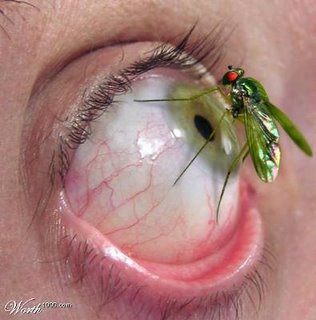
From Harper's Weekly
In Baghdad two tennis players and their coach were killed for wearing shorts, and a Marine helicopter was shot down over the Anbar province. British MP George Galloway said that an assassin would be "morally justified" in killing Prime Minister Tony Blair. In Germany, at the official opening of the Hauptbahnhof, the largest railway station in Europe, a man went on a rampage and stabbed 35 people. Because one of
the first people he stabbed was HIV positive, concerns were raised that some of the subsequently stabbed may also become infected. A team of researchers in southern Cameroon said that they had found wild chimpanzees carrying the SIVcpz virus, thought to be the precursor to HIV. In Washington, D.C., police searched the 50 acres of office space in the Rayburn House Office Building to find that the "gunfire" that precipitated a several hour lockdown was actually a pneumatic hammer. A Nebraska judge sentenced a man convicted of sexually assaulting a child to probation because the man is too short for prison. The Supreme Court voted unanimously that police may enter a house without a warrant in order to break up a fight. Jack Kevorkian was very ill and reportedly had less than a year to live. Scientists in North Carolina said that they could grow new, functional rabbit penises, and a jury in Illinois awarded a woman $5 million in compensation for her ruined vagina. In Norway a grevling, or badger, wrecked a man's bedroom. An analysis of FCC decisions found that the following terms or phrases are neither indecent nor profane: "a lot of crap," "ass is huge," "ass," "bitch," "damn," "dick," "dickhead," "fire his ass," "for Christ's sake," "hell," "kick-ass," "kiss my ass," "my ass," "pissed off," "poop," "sex with a dog," "singers that suck," "sit their asses down," "sucked," "up yours," "wiping his ass," and "you suck." NASA scientists claimed that they could extract oxygen from lunar soil, Pat Robertson claimed to have leg-pressed 2,000 pounds, and Senator Bill Frist helped give a gorilla a root canal. A study found that most British men are cry babies.
Tuesday, May 30, 2006
Drinking for Your Ear
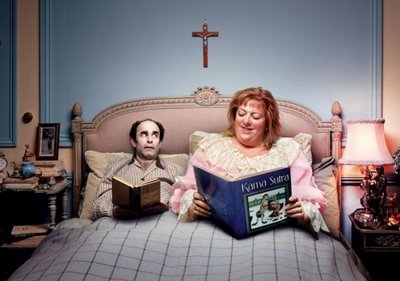
DRINKING red wine can stop you going deaf in later life, according to American research. The wine counteracts ear damage such as that said to be caused by loud noise or antibiotics. Green tea and aspirin have similar benefits. Antioxidants in red wine can help neutralise free radicals, which can damage hairs in the inner ear, said a US research team.
What Romy Garduce Should Have Done
You were beaten on top of Mt. Everest, when you were clearly ahead? You were taking all comers and when you were the 3rd, you started saying that it's not a race after all. Oh Cmon Garducchh!!! As we say in Baguio, agiinamotayon. The problem is you were the Manny Pacquiao among the climbers, meaning you were the one with the most commercial endorsements and then you ended up third. How do you explain that to your sponsors? So you decided that the only thing you can be first is to be the first to go home. Very funny. If I were you, I would have done this. Then I would have been the first amongst everyone who climbed Mt. Everest 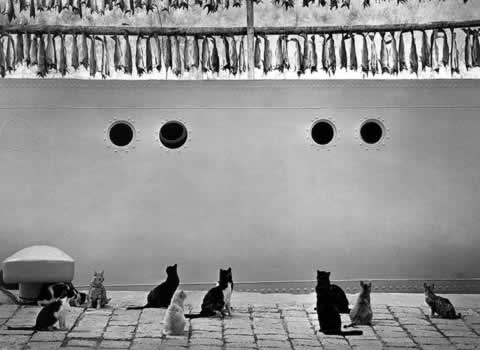 Finnish photographer Pentti Sammallahti took this cool photo of cats staring longingly at drying fish in Islati, Iceland.
Finnish photographer Pentti Sammallahti took this cool photo of cats staring longingly at drying fish in Islati, Iceland.
 Finnish photographer Pentti Sammallahti took this cool photo of cats staring longingly at drying fish in Islati, Iceland.
Finnish photographer Pentti Sammallahti took this cool photo of cats staring longingly at drying fish in Islati, Iceland.
Sunday, May 28, 2006
Koreatown

Baguio now has the most number of Koreans after Makati. One of the best reasons I got is that there are many wongbok in Baguio and wongbok means kimchi. Here's the new lowdown on kimchi from LA Times:
Many see beneficial powers in the national dish, and some scientists agree. Critics keep quiet.
By Barbara Demick, Times Staff Writer
May 21, 2006
SEOUL — One might call it the chicken soup of Korea.
For years, Koreans have clung to the notion that kimchi, the pungent fermented cabbage that is synonymous with their culture, has mystical properties that ward off disease. But what was once little more than an old wives' tale has become the subject of serious research, as South Korean scientists put kimchi under their microscopes.
Last month, scientists at the Korea Atomic Energy Research Institute unveiled a kimchi especially developed for astronauts to prevent them from getting constipated in space. A researcher at Ewha Woman's University in Seoul reported that kimchi lowered the stress levels of caged mice by 30%.
At the Kimchi Research Institute in Busan, hairless mice fed kimchi were reported to develop fewer wrinkles. With a government grant of $500,000, the institute is developing a special anti-aging kimchi that will be marketed this year. Other new products are anti-cancer and anti-obesity kimchi.
"We are proud that we can use scientific methods to confirm the health benefits of our traditional food," said Park Kun-young, who heads the institute.
Kimchi specialists abound here. The library of a kimchi museum in Seoul holds more than 2,000 books about kimchi and thousands more dissertations. ("A Kinetic Model for Lactic Acid Production in Kimchi" was among the recent titles.) New theses are being added at the rate of 300 per year.
Kimchi is a matter of great national pride, and much of the research has been government-funded.
"I think kimchi practically defines Korean-ness," said Park Chae-lin, curator of the museum.
Understandably, perhaps, dissenters on the topic of its healing power are circumspect.
"I'm sorry. I can't talk about the health risks of kimchi in the media. Kimchi is our national food," said a researcher at Seoul National University, who begged not to be quoted by name.
Among the papers not to be found in the vast library of the kimchi museum is one published in June 2005 in the Beijing-based World Journal of Gastroenterology titled "Kimchi and Soybean Pastes Are Risk Factors of Gastric Cancer."
The researchers, all South Korean, report that kimchi and other spicy and fermented foods could be linked to the most common cancer among Koreans. Rates of gastric cancer among Koreans and Japanese are 10 times higher than in the United States.
"We found that if you were a very, very heavy eater of kimchi, you had a 50% higher risk of getting stomach cancer," said Kim Heon of the department of preventive medicine at Chungbuk National University and one of the authors. "It is not that kimchi is not a healthy food — it is a healthy food, but in excessive quantities there are risk factors."
Kim said he tried to publicize the study but a friend who is a science reporter, told him, "This will never be published in Korea."
Other studies have suggested that the heavy concentration of salt in some kimchi and the fish sauce used for flavoring could be problematic, but they too have received comparatively little attention.
Even the most ardent proponents say that at times, kimchi might be too much of a good thing.
Nutritionist Park, who in addition to the Kimchi Research Institute heads the Korea Kimchi Assn. and the Korean Society for Cancer Prevention, said that traditionally, kimchi contained a great deal of salt, which could combine with red pepper to form a carcinogen.
Nowadays, with refrigeration, less salt is needed, Park said. Instead of preserving kimchi by burying it in earthenware jars in the garden, many Koreans own specially designed refrigerators to keep it at ideal temperatures.
The beneficial power of kimchi comes from the lactic acid bacteria (also found in yogurt and other fermented foods) that helps in digestion and, according to some researchers, boosts immunity. In addition, the vegetables are excellent sources of vitamin C and antioxidants, which are believed to protect cells from carcinogens. The high fiber content aids bowel function.
Although the most recognizable kind of kimchi is made with Chinese cabbage, other variants are made with radish, garlic stalks, eggplant and mustard leaf, among other ingredients. In all, there are about 200 types of kimchi — plastic models of which are on display at the kimchi museum in Seoul.
Korean pride swelled when the U.S. magazine Health listed kimchi in its March issue as one of the world's five most healthful foods. (The others are yogurt, olive oil, lentils and soy.)
In fact, interest in kimchi's curative properties has risen proportionally with fears related to diseases such as severe acute respiratory syndrome and avian flu.
During the 2003 panic over SARS, people started remarking that Korea seemed curiously immune, and speculation revolved around kimchi.
In March, LG Electronics put out a new line of air conditioners that have an enzyme extracted from kimchi (called leuconostoc) in the filters.
Healthful or not, the kimchi industry is booming, abroad and at home. South Koreans consume 77 pounds of it per capita annually, and many people eat it with every meal, according to industry statistics. Koreans traveling abroad seem to take it with them everywhere.
And that will soon include outer space.
"Koreans can't go anywhere without kimchi," said Byun Myung-woo, head of a team of scientists who developed a specially sterilized form of kimchi for astronauts.
The idea came about because taste and smell are greatly diminished in low-gravity conditions, giving astronauts a preference for strongly spiced foods. And astronauts often suffer from digestive problems.
"The kimchi will prevent constipation and enhance their digestive functions," Byun said.
Space kimchi is expected to make its debut in 2008, when the first South Korean astronauts are scheduled to travel on the Russian spacecraft Soyuz.
Lost: The Final Season
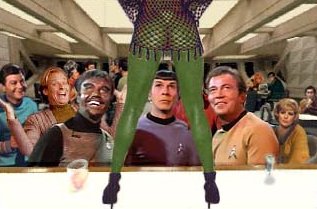
Episode Nine: Look Once, Look Well
Don’t go round in circles. Once you’ve checked a site, don’t go back and check it again. No matter how promising a site—if the object wasn’t there the first time, it won’t be there the second.
Assuming, of course, that your first check was thorough.
Was it? If not, go back and do it again—thoroughly.
Episode Ten: Eureka Zone
The majority of lost objects are right where you figure—once you take a moment to stop and figure.Others, however, are in the immediate vicinity of that place. They have undergone a displacement—a shift in location that, although minor, has served to render them invisible.
Some examples:
A pencil has rolled beneath a typewriter.
A tool has been shoved to the rear of a drawer.
A book on a shelf has gotten lodged behind other books.
A folder has been misfiled, several folders away from where it belongs.
Objects are apt to wander. I have found, though, that they tend to travel no more than eighteen inches from their original location. To the circle described by this eighteen-inch radius I have given a name. I call it the Eureka Zone.
Episode Eleven: Tail Thyself
If you still haven’t found you object, it may be time to Recreate the Crime. Remove your thinking cap and don your detective’s cap. For you are about to follow your own trail. Let’s create a typical scenario. You come home from work and find a letter in the mail. Some time later you’re ready to read it…but it’s missing. You’re perturbed and perplexed. Where’s that letter?
Okay, start at the door and retrace your steps since returning home. Where in the house did you go? To what specific locations? Stop at each of them and look for the letter.
Hmm, a coat thrown across a chair. You were here. (Check under the coat and in its pockets.) A depression in the sofa. You were here. On the kitchen counter, a glass. You were here. On the table by the armchair, candy wrappers and a novel. You were here. And marking your place in the novel—aha! That missing letter.
Episode 12: It Wasn’t You
When all else has failed, explore the possibility that your object hasn’t been misplaced. Rather, it’s been misappropriated. Perhaps someone you know has borrowed your umbrella. Or eaten your doughnut. Or taken your magazine into another room.
Approach that person and inquire if such might not be the case. (“Have you by any chance seen my…?” is a tactful way to phrase this.)
Basketball Madness Part 1

From Boston Globe's The Art of Sports
The art critic Dave Hickey builds his essay ''The Heresy of Zone Defense" (published in his 1997 collection ''Air Guitar") around another such moment of transcendent athletic beauty: Julius Erving driving baseline in the 1980 NBA Finals, veering though the air around Kareem Abdul-Jabbar, under the backboard, and then, somehow, reaching back under the glass for a reverse layup. After the game, Magic Johnson joked that the Lakers weren't sure at the time whether to inbound the ball or ask Erving to do it again.
''Everyone who cares about basketball knows this play," Hickey writes, and it's true: Even for sports fans like myself who were merely toddlers in 1980, the words ''Dr. J" and ''reverse layup" are sufficient to summon the precise mental image.
Hickey attributes the universal joy inspired by Erving's play to the fact that it ''was at once new and fair": within the rules of the game invented in 1891 by James Naismith, and yet impossible for Naismith (or anyone else, for that matter) to have anticipated until Dr. J actually pulled it off. The relationship between fair play and aesthetic appreciation may also explain why replays of Mark McGwire and Sammy Sosa's record-setting 1998 home run chase felt breathtaking just a few years ago but now seem to have lost their capacity to inspire strong feelings.
Hickey also writes of the aesthetic rewards reaped by attentive spectators who know ''what to watch for" (in basketball, according to Hickey, ''basically, everything"). As in art or music, such knowledge isn't strictly necessary but it deepens the aesthetic experience. I enjoy modern art, although I have only a layman's understanding of it. My sense of the beauty of Ray Allen's perfect jump-shooting form, on the other hand, is enhanced by the innumerable bricks I've hoisted over two decades of pickup hoops.
Our desire to better understand all the nuances of our complex games accounts for the prodigious number of retired all-stars working as sports ''analysts," as well as the countless interviews and profiles of celebrity-athletes (athletic celebrities?) that go out each day to newsstands and over the airwaves. The problem, as anyone who's watched their share of post-game interviews knows, is the incredible banality with which athletes typically talk about the extraordinary abilities and accomplishments for which they are renowned. Having run for four touchdowns or hit three home runs in a game, shouldn't there be more to say about the experience than ''It feels great" and ''I'm just happy to be here"?
David Foster Wallace devotes his essay ''How Tracy Austin Broke My Heart" (included in his latest book, ''Consider the Lobster") to the conundrum. Onetime tennis phenom Austin disheartens Wallace because he can't reconcile her on-court brilliance, not only physical but mental, with her staggeringly insipid tennis memoir. It's certainly not a lack of intelligence, as Wallace points out: ''Anyone who buys the idea that great athletes are dim should have a close look at an NFL playbook, or at a basketball coach's diagram of a 3-2 zone trap."
Wallace ultimately concludes that looking to athletes for insights into the nature of athletic beauty discounts the possibility that athletes are capable of such feats precisely because they can ''invoke for themselves a cliché as trite as 'One ball at a time' or 'Gotta concentrate here,' and mean it and then do it." Any of us in the stands or watching at home, under such circumstances and scrutiny, would buckle and fail precisely because we think too much (that, and the fact that most of us have mediocre hand-eye coordination and aren't in particularly good shape).
There's no time for distractions or doubts when Kareem is rising into your path to block your shot or when you're deciding whether to swing at a full-count slider with the opening game of the World Series on the line. It may well be, Wallace writes, ''that those who receive and act out the gift of athletic genius must, perforce, be blind and dumb about it-and not because blindness and dumbness are the price of the gift, but because they are its essence."
Of course, intellectualizing any innately emotional or physical experience (say comedy, or sex) runs the risk of diminishing, if not destroying, the pleasure we take from it. Thankfully, for the 9-year-old kid who watched as Flutie took the final snap of that B.C.-Miami game (my brother and I were lying on the floor in front of the TV; my grandmother was visiting and across the room), there was no danger of that. I'll never forget the moment: the high arc of the spiraling football, the diving catch in the end zone, and then a wave of elation, intense beyond description, on the field but also far beyond it. A thing of beauty.
Lost: The Second Season
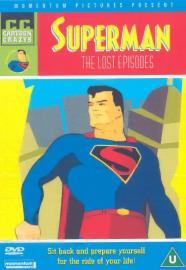
Episode 5: Domestic Drift
Many objects do have a designated or customary place where they are kept. But the reality is that they aren’t always returned there. Instead, they are left wherever last used. Such objects have undergone Domestic Drift. They could be anywhere in the house or out in the yard. Relax. Get comfortable. Pour yourself a cup of coffee. Now try to remember. Where were you last using that pliers, or tape measure, or fountain pen? Where did you last have it? Because that’s precisely where it still may be.
Episode 6: You’re Looking Right at It
All right. You checked where it’s supposed to be, where it was last used, or where it might have been casually tossed. And it wasn’t there. Or…was it? It is possible to look directly at a missing object and not see it. This is due to the agitated state of mind that often accompanies a misplacement. Go back and look again. It may be staring you in the face. Occasionally, our distress is such that not only do we overlook an object—we forget what we’re looking for! To avoid this, repeatedly murmur the name of the object. (“Potholder, potholder, potholder.”) But why the agitation? Have we forgotten the second C? Return to your armchair and get calm
Episode 7: The Camouflage Effect
Don’t be fooled. Your object may be right where you thought it was—but it has become hidden from view. Be sure to check under anything that could be covering your object, having inadvertently been placed on top of it. I call this the Camouflage Effect. Among the most common offenders are newspapers and sombreros.
Episode 8: Think Back
You were there at the scene of the misplacement. You were there when the object was put down—was left in an obscure location—was consigned to oblivion. You were there—because you did it! So you must have a memory—however faint—of where this happened.
Are you prepared to think back and retrieve that memory? If so, you may soon be crying out “Of course!” and making a beeline to that forgotten place.
Driving Mr. Bayani
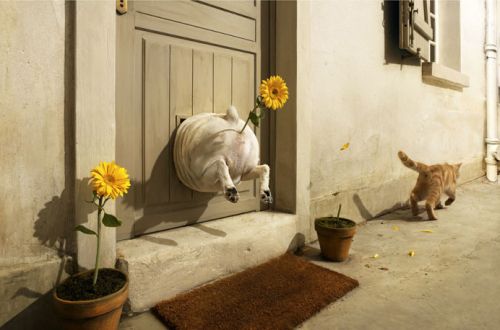
The MMDA distributed deodorants, tawas (potash alum) and breath fresheners to drivers and conductors of public vehicles in Manila last Friday. I happened to be there when MMDA Bayani Fernando was handing out the deodorants and tawas to the police enforcer. Which is weird because if you are that close to the police, you are really in danger. I heard that some of the drivers were insulted. Fernando pointed out that everybody needs to freshen up and it happened that the drivers and conductors are the easiest to approach. And they make good copy. I wondered why the wires didn't make much fuss on this. How long before Ananova pick this up as their strange news of the week.
Lost: The First Season

Episode 1: Don’t Look for It
Something’s lost, and your first thought—your basic instinct—is to look for it. You’re ready to start rummaging about. To hunt for it in a random, and increasingly frenetic, fashion. To ransack your own house. This is the most common mistake people make. And it can doom their search from the start. I know you’re eager to find that lost item. But not yet. Don’t look for it yet. Wait until you have some idea where to look.
Episode 2: It’s Not Lost—You Are
Have you ever stopped to think that maybe it’s you that are lost—not those keys or that umbrella? Because a fundamental truth is this: There are no missing objects. Only unsystematic searchers. Accept that—copy it down and tape it to your mirror—and you’ll soon be finding things with ease.
Episode 3: Remember the Three C’s
To find a lost object, you must be in the proper frame of mind. And that means paying attention to the 3 C’s.
They are:
COMFORT
Start by making yourself comfortable in an armchair or sofa. Have a cup of tea, perhaps, or a stick of gum, or pipeful of tobacco.
CALMNESS
Next, empty your mind of any unsettling thoughts. Pretend that the sea is lapping at your feet. Or that you’re sitting in a garden full of birds and flowers.
CONFIDENCE
Finally, tell yourself you will locate that missing object.
Episode 4: It’s Where It’s Supposed to Be
Believe it or not, things are often right where they’re supposed to be. Is there a place where your missing object is normally kept? A particular rack, or shelf, or drawer? If so, look there first. You may actually have hung up your coat last night. Or put the dictionary back on the shelf. Or returned the tape measure to the tool drawer. Even if you didn’t, someone may have done it for you.
Saturday, May 27, 2006
Friday, May 26, 2006
Cheeta
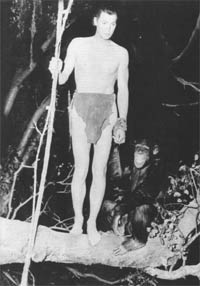
One of the only things I learned from Manila Bulletin when it was the only one coming out during Holy Week was that Cheeta is alive! Yes, the chimpanzee who played the other love interest of Johnny Weissmuller (before World war II!, is still alive.
Cheeta turned 74 on April 9th, 2006 and has been recognized by the Guinness Book of World Records as the world's oldest chimpanzee. He's 4 foot tall and 142 pounds. He starred in 12 Tarzan movies during the '30's and 40's. Dan Westfall adopted Cheeta in 1992 from his uncle Tony Gentry, an animal trainer who worked in Hollywood and obtained Cheeta from Africa in the 1930s.
Cheeta now spends his days socializing with other primates and his caregivers. Cheeta's staple diet consists of fresh fruit, vegetables, and monkey chow.
The sanctuary's primates are provided with a variety of activities to stimulate their intellect and curiosity. One of the activities is painting, which allows chimpanzees to mimic their innate behavior of inventing and using tools.
Westfall says that Cheeta has become a wonderful abstract artist and has trademarked Cheeta’s creations as “Ape-stract.” “They are pretty” says Westfall, who gives the art to donors who support the non-profit with a donation of $125 or more. The proceeds go to support the Cheeta Primate Sanctuary.
Throw Out Your Katol. Try this Chinese Lamok Trap

How to build a Mosquito trap.
Materials Needed:
2000ml (2 liter) bottle
50 gram (brown?) sugar
1 gram yeast
Thermometer
Measure cup
Knife
Black paper

1. Cut the top of the bottle as shown
2. Put 200ml hot water in the bottle, stir with 50gram brown sugar. Put the sugar water in cold water to cool it down til 40C (temperature).
They use a bigger container with cold water - put the small cup that they use to make sugar water in that container and that stick is a thermometer because they want the sugar water to cool down to 40C (temperature).
3. After cooling down, put the sugar water in the bottle then add the yeast.
No need to mix the yeast with the sugar water. When yeast ferments, it creates carbon dioxide.
4. When you cut the bottle, dont throw the top part away because that’d be needed for step 4 - you see they put the top upside down to fit into the bottle.
Carbon dioxide will be released from where we drink the bottle so make sure to seal the edge.
5. Put black paper around the bottle since mosquitos like dark places and carbon dioxide. This mosquito trap will then start working.
Mosquitos fly around the corner, so the best place to place the trap is at some dark corner.
TIPS: Put the trap in some dark and humid place for 2 weeks, you’ll see the effect. You’ll have to replace the sugar water + yeast solution every 2 weeks
Thursday, May 25, 2006
Lordi, Hack Hack Pyow
I am in Manila still attending a workshop. I am just too glad that Taylor Hicks won and so I give you Harper's Weekly:
Gay Iraqis were fleeing the country to avoid being killed by militias. American troops were using lasers to "dazzle" Iraqi drivers who do not stop at checkpoints; if used properly, said a Pentagon spokesman, the laser light will not blind its target. A 4.3-million-square-foot mall opened in the Philippines, and thousands of people protested against affirmative action in New Delhi. Fidel Castro denied that he had a fortune worth $900 million. "Why would I want money," he asked, "especially now that I'm going to be 80 years old?" His doctor said that Castro was in excellent health and could live another 60 years. A man with no legs climbed to the summit of
Mt. Everest, and the mayor of Scottsdale, Arizona, was offended by a new restaurant called the Pink Taco. The Hershey Company opened a new health center to study the benefits of cocoa, and Ray Nagin was re-elected mayor of New Orleans. Scottish scientist Klaus Zuberbuhler found that Nigerian putty-nosed male monkeys say "pyow" to warn of leopards and "hack" to warn of eagles. "Pyow," said a monkey. "Hack hack pyow hack hack." A patent was filed for a Pentagon-funded "controllable launcher for propelling a payload" that can shoot SWAT teams onto the roofs of tall buildings. About 2,000 gallons of Sunny D concentrate leaked into a river in England, killing fish and turning the water bright yellow. Finnish horror rock group Lordi (whose most recent album is "The Arockalypse") won the Eurovision Song Contest, and President George W. Bush promised to uphold "the tradition of the melting pot." Scientists in Germany said that apes can plan ahead.
I know what you're thinking.
Gay Iraqis were fleeing the country to avoid being killed by militias. American troops were using lasers to "dazzle" Iraqi drivers who do not stop at checkpoints; if used properly, said a Pentagon spokesman, the laser light will not blind its target. A 4.3-million-square-foot mall opened in the Philippines, and thousands of people protested against affirmative action in New Delhi. Fidel Castro denied that he had a fortune worth $900 million. "Why would I want money," he asked, "especially now that I'm going to be 80 years old?" His doctor said that Castro was in excellent health and could live another 60 years. A man with no legs climbed to the summit of
Mt. Everest, and the mayor of Scottsdale, Arizona, was offended by a new restaurant called the Pink Taco. The Hershey Company opened a new health center to study the benefits of cocoa, and Ray Nagin was re-elected mayor of New Orleans. Scottish scientist Klaus Zuberbuhler found that Nigerian putty-nosed male monkeys say "pyow" to warn of leopards and "hack" to warn of eagles. "Pyow," said a monkey. "Hack hack pyow hack hack." A patent was filed for a Pentagon-funded "controllable launcher for propelling a payload" that can shoot SWAT teams onto the roofs of tall buildings. About 2,000 gallons of Sunny D concentrate leaked into a river in England, killing fish and turning the water bright yellow. Finnish horror rock group Lordi (whose most recent album is "The Arockalypse") won the Eurovision Song Contest, and President George W. Bush promised to uphold "the tradition of the melting pot." Scientists in Germany said that apes can plan ahead.
I know what you're thinking.
Sunday, May 21, 2006
FlashBack

When a person's life is in danger, a phenomenon known as 'time-dilation' can occur. This is when, during a car crash for example, time seems to slow down or become frozen.
Here is BBC's take on why we have a flashback of our lives when we are in danger:
In these cases the body's internal clock speeds up when facing a potential catastrophe, so that it can take in more information more quickly and function more effectively in an emergency.
This is also a phenomenon actively sought by elite sportspeople, when they get 'in the zone'.
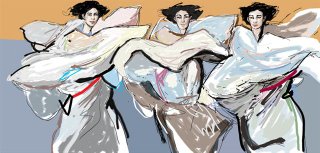 Some of the chemicals in the brain, such as dopamine, can affect our perception of time. Deficiencies in these chemicals can lead to brain disorders.
Some of the chemicals in the brain, such as dopamine, can affect our perception of time. Deficiencies in these chemicals can lead to brain disorders. In today's technological age, the body's natural clocks are being hijacked by timetables, schedules and diaries. By paying more attention to our watches, rather than our internal clocks, could we be losing touch with time as it should be perceived?
Sige na nga, you are one of those hypocrites who wants to ban "Da Vince Code and Tom Hank's Heinous Hairdo" because it corrupts our morals. Then watch Ten Commandments.
Memoriam
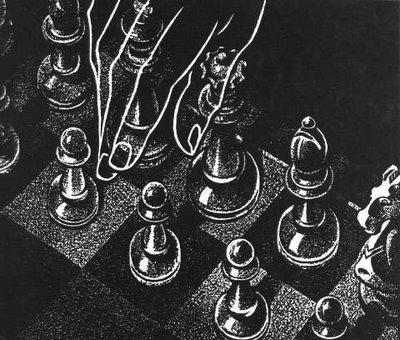
Ryan, a friend from Candon, came to Baguio to light a candle for his cousin, a recent PMA graduate who died exactly a year ago when the plane he was piloting crashed in Kias. Martin Caoili, an internationally-known faithhealer since the 1970s, also died last Sunday. He is a good friend. Also, my father died May 20, 1990.
Here is a poem I wrote two years ago. It came out last year in "Honoring Fathers: An International Anthology."
PLAYING ONLINE CHESS WITH MY FATHER FOURTEEN YEARS AFTER HIS DEATH:
THREE SONNETS
Opening
Hair on your nape don't stand up every day
(2:15 am) you are logged in the Internet.
And I'm in my 15th chess game and with eight straight
Wins, I was on a mini-streak when he came to play.
So I thought, What the heck and wrote, "Hello ."
And he answered, "Thank you." I answered, "What for?"
Then I remembered our last talk together. "What for,"
I stupidly replied when he thanked me 14 years ago
When I should have known, he was thanking
Me for caring with him in the hospital. I am like that
In chess: disdaining gambits and head-on openings,
Preferring Sicilian and hypermoderns. Blame that
To my being the youngest and my father (1st teacher),
Whose first move (PK4) exposes the king, the father.
Middle game
Middle games bore me. My father was middle-aged
When he had me. For the past 20 years, I've been told
I write like an old man. Maybe because I was weaned old
By my brother's Beat books and my dad's faded
French classics and 60's magazines. As a prudent gesture,
I was not baptized till I'm six because dad wanted me to choose
The gods to believe. So maybe now I had to impose
This on my daughter. During his wake, people always picture
Him a gentleman. Not now that his bishops hold fort
The grand diagonals. From him, I lately preferred patience over
Devotion, quiet moves over loud sacrifices, bishops over
Galloping knights. Although I missed trashtalking in court,
Online I am all business. Like fatherhood, chess after centuries,
Refined our cruelties by bringing nobility to the pieces.
Endgame
In the movies, Death plays Chess. Do I take
That he always play with black, with a timer and Deep Blue precision?
My father brought me to an endgame which I reckoned
I can't win unless I wait for an impatient mistake
Which is unthinkable since my Dad spent most of his years punching
Clocks which I have disdain of. But he loved to cite
The rule to give enemies a chance to escape, not so they fight
Us for another day but to give you respect while they lie dying.
While I was two pieces down, he moved his king
Unnecessarily so I can give him a perpetual check.
His king and my rook in a brief tango before he said, "What the heck.
It's a draw!" I said, "Tnx. Another?." He said, "Next time. And bring
Your chessbooks of the crazy ones who are on the other side.
You just might beat Death." Then he left at the exact hour he died.

Saturday, May 20, 2006
Benguet Cowboy 2
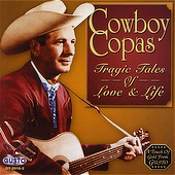
Lloyd “Cowboy” Copas was born in Adams County, Ohio. His number one debut single “Filipino Baby” hit number one on four country charts. He also released various top-ten hits such as “Signed, Sealed and Delivered”, “Tennessee Waltz” and “Tennessee Moon”. His biggest hit “Alabama” rode to the top of the charts at number one for three months in the last half of 1960.
An early influence on Johnny Cash, Cowboy Copas produced some seminal work that was largely (and shamefully) forgotten as time went on. Like Ernest Tubb, Copas laid a deep, home-grown vocal style over simple, proto-honky-tonk accounts of trouble and heartbreak. As this album's title indicates, Copas is at his best when observing the darker side of life. His voice is full of so much yearning in "The Postman Just Passes Me By" that he seems about to die from loneliness. He's anything but humorless, though, as witnessed by the (literal) gallows humor of the rockabilly-tinged "Hangman's Boogie" with its refrain of "swing high, swing low," and by the light-hearted hard-luck story "As Advertised." Others may have had more mellifluous voices, but Copas invested his songs with enough honesty, passion and humor to make him one of country's unsung greats.
Cowboy Copas life was cut short in the tragic airplane crash that also killed Randy Hughes, Hankshaw Hawkins and Patsy Cline – the pilot of the plane was Copas son-in-law. His last single, “Goodbye Kisses” hit the top fifteen in April 1936, one month after his death.
There is a Boardmember Copas in Benguet. Related?
Benguet Cowboy and Camote Bill
Cordillera is probably the only place where American cowboy culture affects daily life. Bukidnon may have their horse fights but anyone there can tell the difference between Garth Brooks and Brooks & Dunn? Sta. Ana Racetrack may have their race track but where do their horses retire? In Baguio's Wright Park, of course. The gays may have adored the award-winning gay tragic movie, "Brokeback Mountain" but where can the gays have a chance to dance with real-life cowboys. The recent issue of Baguio Guidebook has one such story.
You may not have heard of "Benguet cowboy" but it has become a cultural meme (unit of cultural transmission or imitation) here.
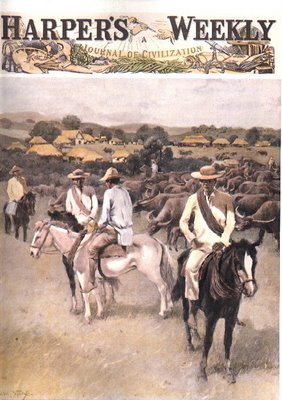 Consider walking along the sidestreets here. Along General Luna Road, you will pass by shops selling made-to-order cowboy boots, belts, Stetson hats (remember the Dallas TV series?) and even leather gaucho pants.
Consider walking along the sidestreets here. Along General Luna Road, you will pass by shops selling made-to-order cowboy boots, belts, Stetson hats (remember the Dallas TV series?) and even leather gaucho pants.
From there, go down Belfrant Hotel and you see tapes of homebred cowboy singers produced locally and selling like hotcakes not only here but in Hongkong where there are many domestic helps from the Cordillera.
In the ukay ukay (second hand) stores here, the bestselling stuff at least in interior Cordillera are maong jackets and flannel shirts. A favorite FM station here features country western music from sun up to beyond sundown.
When one local cable station here pulled out its Country Music Television, many cancelled their subscriptions.
This is the only place with two politicians named Rocky.
To explain this fascination with American cowboys, people talk about Baguio a hundred years ago as a pastureland for cows. In fact, Mateo Carino, who used to own Camp John Hay and other parts of the old Baguio known then as Kafagway, was a ranchero.
Baguio used to be cow pastureland and most of its early pioneers were cowhands but it doesn't necessary translate to a cowboy culture as pervasive as now.
Gerard Finin in his recent book, "The Making of the Igorot: Contours of Cordillera Consciousness" said that the Cowboy fever has more to do with "Camote Bill."
Finin, who is deputy director of the East-West Center's Pacific Islands Development Proigram in Hawaii and was first fascinated with the Cordillera when he became a Peace Corps volunteer, said that the mining boom in Baguio brought in American mining executives from the Cowboy West.
"Coming from states such as Arizona, Texas and California, most so called sourdoughs and mining engineers, before reaching the Philippines , either came out of the experiences that gave rise to Western folklore or identified with its content," Finin wrote.
The strong flavor of the American "Westernness" was evident in the poem, "Camote Bill," written by James Pike, an engineer of the Benguet Consolidated. It told about the cowboy lifestyle of his fellow mining engineers.
Finin said that the "Postwar education of educated highlanders" adopted the cowboy lifestyle as their cultural model, to differentiate from the "Hispanized" cultural traits of the lowlanders.
"In its outward form, young highlanders pursuing studies in Baguio or employed in the mines took to wearing pants made from rough cotton drill or maong that contrasted with the sharply pressed seda preferred by lowlanders. White shirts were shunned in favor of checkered patterns, frequently accompanied by neckerchief," Finin added.
Cowboy boots and country western music naturally followed the highlander transformation. Barndances and beef barbeques are still popular.
"On the one hand, the cowboy idea served as a powerful metaphor suggesting to highlander men and women their exceptional adaptability and strength to overcome the most adverse circumstances. On the other hand, the image also brought to mind a pioneering spirit associated with isolation that pioneers endure. Ultimately, it embraced the notion of highlanders as brave and heroic figures," Finin said.
So ride to the sunset, Camote Bill.
You may not have heard of "Benguet cowboy" but it has become a cultural meme (unit of cultural transmission or imitation) here.
 Consider walking along the sidestreets here. Along General Luna Road, you will pass by shops selling made-to-order cowboy boots, belts, Stetson hats (remember the Dallas TV series?) and even leather gaucho pants.
Consider walking along the sidestreets here. Along General Luna Road, you will pass by shops selling made-to-order cowboy boots, belts, Stetson hats (remember the Dallas TV series?) and even leather gaucho pants. From there, go down Belfrant Hotel and you see tapes of homebred cowboy singers produced locally and selling like hotcakes not only here but in Hongkong where there are many domestic helps from the Cordillera.
In the ukay ukay (second hand) stores here, the bestselling stuff at least in interior Cordillera are maong jackets and flannel shirts. A favorite FM station here features country western music from sun up to beyond sundown.
When one local cable station here pulled out its Country Music Television, many cancelled their subscriptions.
This is the only place with two politicians named Rocky.
To explain this fascination with American cowboys, people talk about Baguio a hundred years ago as a pastureland for cows. In fact, Mateo Carino, who used to own Camp John Hay and other parts of the old Baguio known then as Kafagway, was a ranchero.
Baguio used to be cow pastureland and most of its early pioneers were cowhands but it doesn't necessary translate to a cowboy culture as pervasive as now.
Gerard Finin in his recent book, "The Making of the Igorot: Contours of Cordillera Consciousness" said that the Cowboy fever has more to do with "Camote Bill."
Finin, who is deputy director of the East-West Center's Pacific Islands Development Proigram in Hawaii and was first fascinated with the Cordillera when he became a Peace Corps volunteer, said that the mining boom in Baguio brought in American mining executives from the Cowboy West.

"Coming from states such as Arizona, Texas and California, most so called sourdoughs and mining engineers, before reaching the Philippines , either came out of the experiences that gave rise to Western folklore or identified with its content," Finin wrote.
The strong flavor of the American "Westernness" was evident in the poem, "Camote Bill," written by James Pike, an engineer of the Benguet Consolidated. It told about the cowboy lifestyle of his fellow mining engineers.
Finin said that the "Postwar education of educated highlanders" adopted the cowboy lifestyle as their cultural model, to differentiate from the "Hispanized" cultural traits of the lowlanders.
"In its outward form, young highlanders pursuing studies in Baguio or employed in the mines took to wearing pants made from rough cotton drill or maong that contrasted with the sharply pressed seda preferred by lowlanders. White shirts were shunned in favor of checkered patterns, frequently accompanied by neckerchief," Finin added.
Cowboy boots and country western music naturally followed the highlander transformation. Barndances and beef barbeques are still popular.
"On the one hand, the cowboy idea served as a powerful metaphor suggesting to highlander men and women their exceptional adaptability and strength to overcome the most adverse circumstances. On the other hand, the image also brought to mind a pioneering spirit associated with isolation that pioneers endure. Ultimately, it embraced the notion of highlanders as brave and heroic figures," Finin said.
So ride to the sunset, Camote Bill.
Friday, May 19, 2006
Aint No Mt. High Enough
The five highest mountains in the country are: Mt. Apo in Davao at 2958 meters; Mt. Pulag in Benguet at 2931 meters; Mt. Tabayoc, also in Benguet at 2842 meters; Mt. Amuyao in Mountain Province at 2702 meters and Mt. Kapiligan in Ifugao at 2670 meters. Rounding up the Top 20 are: Mt. Halcon (Mindoro 2585 meters); Mt. Alchanon (Mountain Province 2576 meters); Mt. Baco (Mindoro 2487 meters); Mt. Saporay (Kalinga) at 2456 meters; Mt. Malindang (Misamis Occidental 2425 meters); Mt. Mayon (Albay 2421 meters); Mt. Kitanglad (Bukidnon 2379 meters); Mt. Camingingel (Mountain Province 2359 meters); Mt. Data (Benguet 2310 meters); Mt. Matumtum (South Cotabato 2293 meters); Mt. Bandbanglang (Kalinga Apayao 2292 meters); Mt. Kalatugan (Bukidnon 2286 meters); Mt. Sto. Tomas (Benguet 2256 meters); Mt. Sicapoo (Ilocos Norte 2234 meters); Mt. Masukut (Apayao 2223 meters); Mt. Banahaw (Quezon 2177 meters); Mt. Lobo (Benguet 2138 meters); Mt. Burray (Ilocos Norte 2115 meters) and Mt. Busa (South Cotabato 2083 meters).
Kortchnoi vs Cow
Baguio entered the consciousness of Russians and other areas beside Mother Russia only in 1978 because the World Chess Championship was held here. The Baguio Convention center was built just for that. I will write about that later. Victor Kortchnoi (then a Swiss emigre) challenged Anatoli Karpov for the crown. It was a long and weird match. I was researching on the benguet cowboy when i learned that Victor Kortchnoi's lost to a cow. Yes, a cow named Lovely. Kortchnoi made his last move and stormed out. Here's the video
Last Week
While you were sleeping last week, this is what happened to our world (from Harper's Weekly). 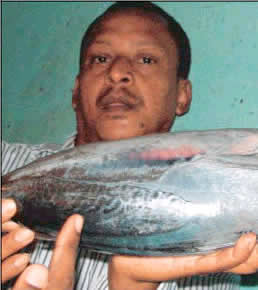 It was revealed that the National Security Agency, with the assistance of AT&T, Verizon, and BellSouth, has secretly stored the phone call records of tens of millions of Americans. "It's the largest database ever assembled in the world" said an anonymous whistleblower. It was reported that the United States was analyzing phone call records of reporters from ABC News, the New York Times, and the Washington Post to determine the identities of CIA employees who leak information to the press. In Canada scientists confirmed that an odd-looking bear shot and killed in April was a "grolar" bear (half polar bear, half grizzly), thus exempting the hunter who shot the bear from paying a grizzly-killing fine. Scientists announced that the recently discovered species of Tanzanian monkey which utters distinctive honk barks is different enough from a mangabey to merit inclusion in its own, new genus, Rungwecebus. At a zoo in the Netherlands three bears ate a monkey. "The macaque," said an eyewitness, "was shrieking and resisting." Bananas, said the United Nations, were in danger of extinction. Snoop Dogg was banned for life from the United Kingdom. A Baptist church in Britain was planning to wash cars with baptismal-font water. Scientists in Illinois said that they had refined a process that transforms pig manure into crude oil, and suggested that up to 3.6 gallons of crude oil could be generated daily per pig. Gas in Venezuela was selling for $0.12 per gallon, and a British inventor claimed to have created a car that gets 8,000 miles per gallon, improving on his previous record of 6,603 miles per gallon. Army recruiters in Portland, Oregon, were under investigation for recruiting an autistic boy for a dangerous position in the cavalry scouts. The Israeli army announced that female soldiers must not lower the waistline of their pants or take in their shirts. A small plane carrying Senator Edward Kennedy (D., Mass.) landed safely after being struck by lightning, and a model airplane crash in Hungary killed two people. Bird flu appeared to have been eradicated in Thailand and Vietnam. In Florida an alligator that recently killed a jogger was caught with the jogger's arms in its stomach. FEMA announced that it was ready for the Atlantic hurricane season, which starts June 1, and a tornado struck Wizard of Oz Drive in Hillsboro, Ohio. Saddam Hussein said that he was ready to die, and a woman in Moon Township, Pennsylvania, found a potato shaped like a heart. The United Nations said that 1,200 people were dying in Congo each day. In Kenya pilgrims were traveling to Mombasa to see a miraculous tuna with a Koranic verse inscribed into its scales. "God," reads the tuna, "is the greatest of all providers."
It was revealed that the National Security Agency, with the assistance of AT&T, Verizon, and BellSouth, has secretly stored the phone call records of tens of millions of Americans. "It's the largest database ever assembled in the world" said an anonymous whistleblower. It was reported that the United States was analyzing phone call records of reporters from ABC News, the New York Times, and the Washington Post to determine the identities of CIA employees who leak information to the press. In Canada scientists confirmed that an odd-looking bear shot and killed in April was a "grolar" bear (half polar bear, half grizzly), thus exempting the hunter who shot the bear from paying a grizzly-killing fine. Scientists announced that the recently discovered species of Tanzanian monkey which utters distinctive honk barks is different enough from a mangabey to merit inclusion in its own, new genus, Rungwecebus. At a zoo in the Netherlands three bears ate a monkey. "The macaque," said an eyewitness, "was shrieking and resisting." Bananas, said the United Nations, were in danger of extinction. Snoop Dogg was banned for life from the United Kingdom. A Baptist church in Britain was planning to wash cars with baptismal-font water. Scientists in Illinois said that they had refined a process that transforms pig manure into crude oil, and suggested that up to 3.6 gallons of crude oil could be generated daily per pig. Gas in Venezuela was selling for $0.12 per gallon, and a British inventor claimed to have created a car that gets 8,000 miles per gallon, improving on his previous record of 6,603 miles per gallon. Army recruiters in Portland, Oregon, were under investigation for recruiting an autistic boy for a dangerous position in the cavalry scouts. The Israeli army announced that female soldiers must not lower the waistline of their pants or take in their shirts. A small plane carrying Senator Edward Kennedy (D., Mass.) landed safely after being struck by lightning, and a model airplane crash in Hungary killed two people. Bird flu appeared to have been eradicated in Thailand and Vietnam. In Florida an alligator that recently killed a jogger was caught with the jogger's arms in its stomach. FEMA announced that it was ready for the Atlantic hurricane season, which starts June 1, and a tornado struck Wizard of Oz Drive in Hillsboro, Ohio. Saddam Hussein said that he was ready to die, and a woman in Moon Township, Pennsylvania, found a potato shaped like a heart. The United Nations said that 1,200 people were dying in Congo each day. In Kenya pilgrims were traveling to Mombasa to see a miraculous tuna with a Koranic verse inscribed into its scales. "God," reads the tuna, "is the greatest of all providers."
 It was revealed that the National Security Agency, with the assistance of AT&T, Verizon, and BellSouth, has secretly stored the phone call records of tens of millions of Americans. "It's the largest database ever assembled in the world" said an anonymous whistleblower. It was reported that the United States was analyzing phone call records of reporters from ABC News, the New York Times, and the Washington Post to determine the identities of CIA employees who leak information to the press. In Canada scientists confirmed that an odd-looking bear shot and killed in April was a "grolar" bear (half polar bear, half grizzly), thus exempting the hunter who shot the bear from paying a grizzly-killing fine. Scientists announced that the recently discovered species of Tanzanian monkey which utters distinctive honk barks is different enough from a mangabey to merit inclusion in its own, new genus, Rungwecebus. At a zoo in the Netherlands three bears ate a monkey. "The macaque," said an eyewitness, "was shrieking and resisting." Bananas, said the United Nations, were in danger of extinction. Snoop Dogg was banned for life from the United Kingdom. A Baptist church in Britain was planning to wash cars with baptismal-font water. Scientists in Illinois said that they had refined a process that transforms pig manure into crude oil, and suggested that up to 3.6 gallons of crude oil could be generated daily per pig. Gas in Venezuela was selling for $0.12 per gallon, and a British inventor claimed to have created a car that gets 8,000 miles per gallon, improving on his previous record of 6,603 miles per gallon. Army recruiters in Portland, Oregon, were under investigation for recruiting an autistic boy for a dangerous position in the cavalry scouts. The Israeli army announced that female soldiers must not lower the waistline of their pants or take in their shirts. A small plane carrying Senator Edward Kennedy (D., Mass.) landed safely after being struck by lightning, and a model airplane crash in Hungary killed two people. Bird flu appeared to have been eradicated in Thailand and Vietnam. In Florida an alligator that recently killed a jogger was caught with the jogger's arms in its stomach. FEMA announced that it was ready for the Atlantic hurricane season, which starts June 1, and a tornado struck Wizard of Oz Drive in Hillsboro, Ohio. Saddam Hussein said that he was ready to die, and a woman in Moon Township, Pennsylvania, found a potato shaped like a heart. The United Nations said that 1,200 people were dying in Congo each day. In Kenya pilgrims were traveling to Mombasa to see a miraculous tuna with a Koranic verse inscribed into its scales. "God," reads the tuna, "is the greatest of all providers."
It was revealed that the National Security Agency, with the assistance of AT&T, Verizon, and BellSouth, has secretly stored the phone call records of tens of millions of Americans. "It's the largest database ever assembled in the world" said an anonymous whistleblower. It was reported that the United States was analyzing phone call records of reporters from ABC News, the New York Times, and the Washington Post to determine the identities of CIA employees who leak information to the press. In Canada scientists confirmed that an odd-looking bear shot and killed in April was a "grolar" bear (half polar bear, half grizzly), thus exempting the hunter who shot the bear from paying a grizzly-killing fine. Scientists announced that the recently discovered species of Tanzanian monkey which utters distinctive honk barks is different enough from a mangabey to merit inclusion in its own, new genus, Rungwecebus. At a zoo in the Netherlands three bears ate a monkey. "The macaque," said an eyewitness, "was shrieking and resisting." Bananas, said the United Nations, were in danger of extinction. Snoop Dogg was banned for life from the United Kingdom. A Baptist church in Britain was planning to wash cars with baptismal-font water. Scientists in Illinois said that they had refined a process that transforms pig manure into crude oil, and suggested that up to 3.6 gallons of crude oil could be generated daily per pig. Gas in Venezuela was selling for $0.12 per gallon, and a British inventor claimed to have created a car that gets 8,000 miles per gallon, improving on his previous record of 6,603 miles per gallon. Army recruiters in Portland, Oregon, were under investigation for recruiting an autistic boy for a dangerous position in the cavalry scouts. The Israeli army announced that female soldiers must not lower the waistline of their pants or take in their shirts. A small plane carrying Senator Edward Kennedy (D., Mass.) landed safely after being struck by lightning, and a model airplane crash in Hungary killed two people. Bird flu appeared to have been eradicated in Thailand and Vietnam. In Florida an alligator that recently killed a jogger was caught with the jogger's arms in its stomach. FEMA announced that it was ready for the Atlantic hurricane season, which starts June 1, and a tornado struck Wizard of Oz Drive in Hillsboro, Ohio. Saddam Hussein said that he was ready to die, and a woman in Moon Township, Pennsylvania, found a potato shaped like a heart. The United Nations said that 1,200 people were dying in Congo each day. In Kenya pilgrims were traveling to Mombasa to see a miraculous tuna with a Koranic verse inscribed into its scales. "God," reads the tuna, "is the greatest of all providers."
OA Tayo Ngayon. You Can Induce Other People to Dream

Studies show that you can bring about a dream in another person. One way is by holding an open bottle of perfume under the sleeper's nose. Another is by whistling. A third way is by blowing air across the sleeper's face with a fan. Someone else can also affect the content of a sleeper’s dream. For example, turning on a light produces happier dreams. And darkening an already bright room can induce nightmares.
In a study conducted by Dr William Dement, a professor of psychiatry at Stanford University, it was found that dream deprivation produces anxiety, irritability, an inability to concentrate, paranoia, a ravenous appetite, depression, and even suicidal thoughts. The study was very simple. Volunteers were assigned beds in a laboratory. Researchers observed them closely for five nights. Each time a subject's rapid eye movements indicated they were starting to dream (REM sleep), the researchers would wake them up and keep them from dreaming. It seems that it only takes a few days of dream deprivation before the symptoms begin to occur.
Why can’t I remember all of a dream?
How much of a dream we remember depends upon how soon we awaken after the dream. In one study, sleeping subjects were awakened while they were dreaming in REM sleep. Other sleeping subjects were awakened 15 minutes after they were in REM sleep. In 152 out of 191 cases, the subjects awakened during REM sleep remembered they were dreaming and could recall a great deal of content of their dreams. Hardly any of the subjects awakened 15 minutes after their REM sleep could remember dreaming at all. If you’re awakened during or shortly after REM sleep, you’re probably more likely to remember more of your dream.
Stephen Juan, Ph.D. is an anthropologist at the University of Sydney.
Thursday, May 18, 2006
Namaste



Namaste Baguio, the only store in the Philippines (located at Porta Vaga Bldg along Session) selling Nepalese, Tibetan and Hindu products just had its own website. Namaste!
Pacquiao Unites the Country
Boxing superstar Manny Pacquiao has his eye on another prize when he unveils his new fighting song two weeks ago. Not the world super featherweight division but the Nobel Peace Prize.
"Laban Natin Ito," penned by Lito Camo of "Otso-otso" and "Ispageti Song" fame, has Pacquiao dedicating his boxing fight for the unity of the country.
Like his earlier blockbuster, Para Sa Iyo (Ang Laban Na Ito), Pacquiao's new song is a slow tearjerker to the Pinoy heart.
We had an exclusive take on the song before its official launch late this month.
"Paulit-ulit lumaban sa mundo/ At ito'y gagawin para sa iyo/ Kahit puwede kong ikasawi ito/ Itataya ko pa rin ang buhay ko (I fought around the world many times and would do it again for you. Even if I die for it, I will still bet my life)," the song starts.
"Bawat patak ng dugo ko/ para sa pagkaka-isa ng bayan ko," Pacquiao even sang almost at the end of the four-minute song.
"Mahal ko'ng bayan ko. Gayun din sana kayo. Tayo's magkaisa. Kaya natin ito (I love my country and so should you. We should unite and we can do it)," Pacquiao pleaded.
The chorus of the song is: "Laban ko, Laban n'yo. Laban natin ito. Laban ng buong Filipino (This is my fight and your fight. Fight of all Filipinos)"
Pacquiao recorded the song and seven others last month and early this month. The songs, all compositions of Camo, would be included in the new Extreme Magic Sing models of which Pacquiao is the new endorser.
"Laban Natin Ito" will be Pacquiao's signature song during his fight with Mexican challenger Oscar Larios in Manila on July 2; apparently to deny rumors that Pacquiao is not taking Larios, the former two-time super bantamweight champion, seriously.
"Kahit anong mangyari/ Basta sa bayan ko/ Hindi ako susuko/ Laban natin ito (Whatever happens, I will not surrender as long as I'm fighting for the country. This is our fight)," he sang.
This is, however, similar to Pacquiao's first song where he sang, "Kahit buhay ko'y itataya sa 'yo/ Ipagtatanggol kita gamit ay aking kamao (Even my life I will offer to you. I will defend you with my fists)."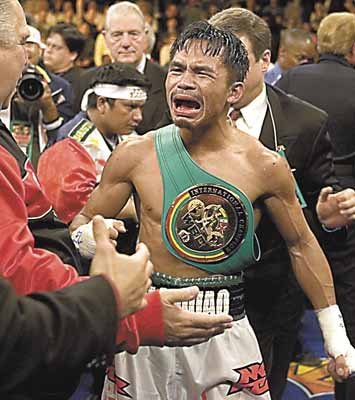
Pacquiao does his boasting in the rap part of the song where he says that you can't hide from Pacman's uppercut and rapid blows.
Pacquiao also sang the new Extreme Music Magic theme song
"Laban Natin Ito," penned by Lito Camo of "Otso-otso" and "Ispageti Song" fame, has Pacquiao dedicating his boxing fight for the unity of the country.
Like his earlier blockbuster, Para Sa Iyo (Ang Laban Na Ito), Pacquiao's new song is a slow tearjerker to the Pinoy heart.
We had an exclusive take on the song before its official launch late this month.
"Paulit-ulit lumaban sa mundo/ At ito'y gagawin para sa iyo/ Kahit puwede kong ikasawi ito/ Itataya ko pa rin ang buhay ko (I fought around the world many times and would do it again for you. Even if I die for it, I will still bet my life)," the song starts.

"Bawat patak ng dugo ko/ para sa pagkaka-isa ng bayan ko," Pacquiao even sang almost at the end of the four-minute song.
"Mahal ko'ng bayan ko. Gayun din sana kayo. Tayo's magkaisa. Kaya natin ito (I love my country and so should you. We should unite and we can do it)," Pacquiao pleaded.
The chorus of the song is: "Laban ko, Laban n'yo. Laban natin ito. Laban ng buong Filipino (This is my fight and your fight. Fight of all Filipinos)"
Pacquiao recorded the song and seven others last month and early this month. The songs, all compositions of Camo, would be included in the new Extreme Magic Sing models of which Pacquiao is the new endorser.
"Laban Natin Ito" will be Pacquiao's signature song during his fight with Mexican challenger Oscar Larios in Manila on July 2; apparently to deny rumors that Pacquiao is not taking Larios, the former two-time super bantamweight champion, seriously.
"Kahit anong mangyari/ Basta sa bayan ko/ Hindi ako susuko/ Laban natin ito (Whatever happens, I will not surrender as long as I'm fighting for the country. This is our fight)," he sang.
This is, however, similar to Pacquiao's first song where he sang, "Kahit buhay ko'y itataya sa 'yo/ Ipagtatanggol kita gamit ay aking kamao (Even my life I will offer to you. I will defend you with my fists)."

Pacquiao does his boasting in the rap part of the song where he says that you can't hide from Pacman's uppercut and rapid blows.
Pacquiao also sang the new Extreme Music Magic theme song
Life is Cheap

Manila Bulletin has a story today about a jeepney driver in Caloocan City who is now 50-50 (very critical condition) because of a very heated argument with a gun-toting passenger over fifty centavos (less than a US cent). The unknown passenger paid eight pesos and, according to the report, demanded his change of fifty centavos immediately. The driver got furious, furious words were lavishly exchanged and the passenger simply shot the driver and left.
I recalled another story, this time in the front page of Philippine Star, about a drunk guy from the South who was beaten by his friends because he lost one peso. The peso coin fell from his pocket and he tried to look for it. Because it was dark, he got a P100 bill and lit it. His friends, certainly pissed, beat him up because apparently they need the money for at least three more beers or maybe a bottle of cheap gin. Our sad republic.
Wednesday, May 17, 2006
Da Vinci Cowards Code

From BBC
The Da Vinci Code is one of the greatest phenomena in the history of fiction publishing and the juggernaut rolls on with the arrival of the movie version. But why are we so profoundly obsessed with a thriller about the Church?
It has sold more than 40 million copies across the world, transforming author Dan Brown into a spectacularly wealthy man.
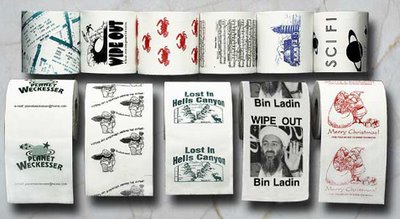 For the few who don't know, it is a thriller telling the story of a race to uncover a massive conspiracy engineered by the Catholic Church to obscure the feminine nature of early Christianity and a shocking secret about Jesus and the Holy Grail.
For the few who don't know, it is a thriller telling the story of a race to uncover a massive conspiracy engineered by the Catholic Church to obscure the feminine nature of early Christianity and a shocking secret about Jesus and the Holy Grail. The Da Vinci Code has been assaulted in equal measures by both historians and theologians, while the critics have sought to emphasise the role of the book's clever marketing to explain the mind-boggling success of a seemingly humdrum thriller.
But as cunning as its marketing has been, Brown's real success has been to effortlessly generate a wave of press coverage and internet discussion.
As Giles Elliott, charts editor of industry magazine the Bookseller, notes, the book has benefited from the Holy Grail of publishing, word-of-mouth.
"It has got that key ingredient - people don't want to be seen not to have read it."
The vehemence of some of the criticism of the book has prompted some to wonder whether there might be some factual elements to this work of fiction.
Mr Elliott continues: "It is a page-turning thriller and apart from anything else, for an agnostic like myself, I find the theories quite interesting and at least as plausible as the official church line first fed to me as a child."
There is no doubt it has tapped into a Zeitgeist that publishers have flirted with for some time.
Mystical topics like the Holy Grail, Dead Sea Scrolls, Knights Templar and the Freemasons have a history of popularity in both fiction and fact. The book makes a direct appeal to women readers, regarded as the big market in fiction, while appealing also to men, with the book feeling as much like non-fiction as a novel.
Modern disrespect
And most of all, the novel taps into the love of conspiracy theories, never stronger than in the age of 9/11, Diana and JFK.
Bishop of Winchester Michael Scott-Joynt, whose cathedral allowed scenes from the movie to be filmed there, believes there is both a modern disrespect for authority and also experts.
"There is a huge attraction in strange stories and cover-ups - it didn't happen like the authorities said it happened, who's been pulling the wool over whose eyes?
"There is a substantial cynicism of the motives of those in authority."
The money from the filming was partly used to produce an exhibition, which runs until 21 July on the scriptural and historical contradictions of the code, and a series of lectures.
Michael Wheeler, who gave one of the lectures, is a visiting professor of literature at a number of universities and a lay canon at the cathedral.
"It is a symptom of our generation. We live in an age of anxiety, of a post-modern sense that we have lost our moorings, a crisis of choice where anything goes. If you choose it, it must be true. Conspiracy theories are very attractive to people. We live in an age of suspicion and anxiety.
"As Tony Robinson [who made a documentary deconstructing the book] said, whatever people believe, they do respect the Gospel. To turn it upside down or deconstruct it is sexy."
And there is perhaps an argument to be made that the book, particularly in Britain where regular churchgoing is a minority activity, is filling a spiritual void.
Professor Mike West, chancellor of Lincoln Cathedral, where filming also took place, believes the book has given a chance for both the Church of England and Catholic Church to engage with people who were previously indifferent.
Nerves touched
"It has made people a little bit more interested in the Jesus story. I don't know how much it would matter if Jesus was married to Mary Magdalene but there is no sensible evidence that that is the case.
"But we think [Brown] touches a few nerves we need to address about the role of women in the Church, about the nature of the Church and how open it is."
Both the Anglicans and Catholics now know better than to expect to harm a Hollywood product with boycotts and protests. Instead, the UK Catholics' Da Vinci Code Response Group's description of the book as "fun and harmless in so far as it is treated as fiction" speaks volumes.
Critics know that many fans regard parts of the book as fact, and Brown has done his part to encourage this.
The opening page is labelled "fact" and is followed by the statement: "The Priory of Sion - a European secret society founded in 1099 - is a real organization."
But as Bishop Scott-Joynt insists: "All this stuff about the Priory of Sion is a 20th Century fantasy." And sadly for Brown, historians seem to side with the bishop, dismissing as a hoax the very documents the author cites as proof.
The "fact" page goes on to assert: "All descriptions of artwork, architecture, documents and secret rituals in this novel are accurate." Art historians have gleefully jumped on Brown's interpretations, and in other details many readers will spot errors.
Harry Potter
But above even the disdain of the churches, and the mockery of historians, perhaps the greatest ire comes from literary figures, possibly angry at a book they see as utterly lacking in literary merit dominating water cooler conversation from here to Timbuktu.
Novelist John Mortimer dismisses the Da Vinci Code in one word: "Unreadable".
"The first page is terrible. It is so badly written, it couldn't be read by anyone who respects the English language."
Along with Harry Potter, it is the typical favourite novel of people who do not read novels. And there are many who believe this makes it a godsend.
The Bookseller's Mr Elliott says there is a standard elitist view of the book.
"It's as if the health of the nation is at risk from this evil author - they should all be reading Ian McEwan. We think slightly differently. It is making lots of non-traditional readers read books. They will move on to other books, reading will be seen as something not elitist."
Oedipal roots
Dr Jennifer Wallace, who teaches literature at Cambridge University, admits she has not read the book but is wary of snobbery.
"The Gothic novels of the 18th Century were the pulp of their day and we regard them as literature now. As far as I can make out it is a great detective novel, a secret is hushed up by institutions. The appeal of detective fiction goes right back to Oedipus finding out the truth about his past. It is arguably the first detective story."
For those who do want the same elements but with a more literary bent, she suggests 18th Century anarchist William Godwin's Things as They Are, or the Adventures of Caleb Williams.
"Conspiracy theories have always appealed to the public because they feel it exposes institutions of power and helps them in their own feeling of powerlessness."
And before the Da Vinci Code was a twinkle in its author's eye there was a compelling tale of Church conspiracy, littered with erudition - Umberto Eco's The Name of the Rose. It even got the Hollywood treatment courtesy of Sean Connery.
As Bishop Scott-Joynt notes: "Umberto Eco is a philosopher of real distinction. [It is] a beautifully crafted, and extraordinarily clever [book] and it doesn't have a page at the beginning that says fact."
Prof Wheeler is happy to give the Da Vinci Code its due, albeit while damning with faint praise.
"As a literary work it's good for nothing. He is not a good writer, it's not been properly edited, but he has a wonderful gift.
"It is in a way an airport novel. The literati like myself wouldn't normally read it. But I find it a page turner and an exciting thriller. It was full of ideas of interest even though I didn't agree with them. At the heart of it there's no historical basis for that view but it is extremely interesting and provocative."
And whatever people's views on the Da Vinci Code, they had better get used to seeing a slew of mystical conspiracy books on their shelves.
The Bookseller has coined a term for it: "Brownsploitation".
Titles such as the Magdalene Cipher, the Lucifer Code and the Last Templar, even when conceived before the blockbuster, are benefiting from the Brown effect.
And when the Archbishop of Canterbury is forced to address the issue in his Easter sermon, you know people's need for mystical conspiracy theories is here to stay.
As he notes: "It's almost that we'd prefer to believe something like this instead of the prosaic reality."
Grease

I heard someone mutter during Holy Week that even the "taong grasa" (people of the grime, the homeless caked in grime) of Baguio speak English. I heard two (all women) indeed speak fluent English by themselves and sometimes with pedestrians. There is one who Mrs. De Guia, the former mayor, told me belongs to a rich family here. There is also one with Tourette syndrome who curses lavishly at Marbay. Just recently I saw one, Paul told me his name is Wilson, who belongs to a rich Chinese family. He said he got desp[aired over a string of business losses and now became a taong grasa. But I'm sure that is a Woolrich shirt, Paul said. Yeah, Baguio is still a small town because we know our beggars. Or maybe we became so familiar with them. There is boom chack chack boom man(blind man using a plastic jug and maracas). The blind man along Skyworld (I had a story that came out in Midweek Magazine about one time when a block of cement fell on him post-1990 earthquake time). One success story is Miller whose guitar skills made him a folk bar circuit regular. There is another in Patria who used to have long hair and looked like Jose Feliciano. There is another on a wheelchair in front of Don Henrico's. These people I give whenever I ahve loose change. Friends tell me, don't give. You are encouraging them. I tell them, we all are beggars. Society is the biggest beggar.
Tuesday, May 16, 2006
Matsui
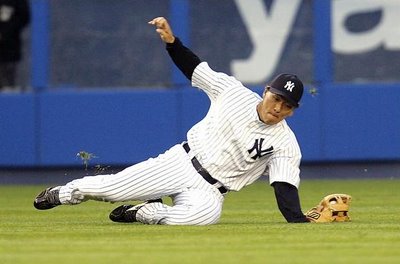
I watched Hideki Matsui dive for the ball during their match with Oakland. This is not good. He will be out for three months and even for the season. Without him, the Yankees are losing. That wrist fracture ended his streak of consecutive games played at 518 with New York and 1,768 overall, including his time in Japan.
His statement: "Due to this injury, I feel very sorry and, at the same time, very disappointed to have let my teammates down. I will do my best to fully recover and return to the field to help my team once again. I would like to thank Joe Torre from the bottom of my heart for having been considerate of my consecutive games played streak these past several years and for placing me in the lineup every day."
Joe Torre is their manager, not the Ilonggo actor.
How to Open Beer with Lighter

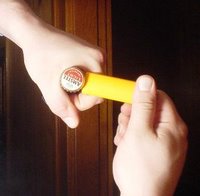
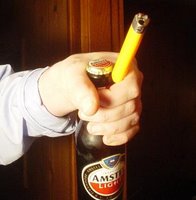
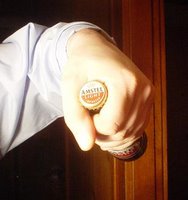
Grab the lighter, and push inwards and upwards. Your index finger is the fulcrum. If you find you don't have the strength, it's not that you're a weakling, although that's probably the case. It's because you're not doing it properly. It should hurt your index finger, just for a second, since you're using it as a fulcrum.

